Читать книгу Energy Storage - Группа авторов - Страница 25
1.3.2 Active Single-Tank Thermocline
ОглавлениеIn a thermocline system, a single tank is used where warm fluid is above colder fluid. These kinds of systems are less expensive than two-tank systems [Figure 1.8]. The heat loss is more in such systems as the hot and cold fluids are in direct contact. The hot and cold temperature regions are separated by a temperature gradient resulting in a thermocline. The density difference in the fluid thermally stratify the fluid in the tank. Buoyancy effects create thermal stratification of the fluid within the tank, which helps to stabilize and maintain the thermocline. Van Lew et al. (2011), Bayón and Rojas (2014), and Biencinto et al. (2014) carried out theoretical and experimental work on thermocline energy storage system for CSP plants.
Figure 1.8 Active single tank thermocline thermal energy storage.
Figure 1.9 Active two-tank indirect thermal energy storage.
Figure 1.10 Passive thermal energy storage.
High-temperature HTF flows into the top of the thermocline and leaves the bottom at low temperature. The thermocline moves downward and adds thermal energy to the system for storage. The thermocline moves upward and removes thermal energy from the system to generate steam and electricity if the flow is reversed. Puerto Errado 2 Thermosolar [see Table 1.2] operated by Novatec Solar España uses linear Fresnel reflector system currently operational in Calasparra, Spain, and has implemented a single-tank thermocline thermal energy storage system. This plant is operated at a temperature range of 140ºC-270ºC. Other plants also use this type of thermal systems and are listed in Tables 1.1, 1.2 and 1.3. Active two tank indirect thermal energy storage is also given in Figure 1.9 and passive type thermal energy storage in built with solar tower technology is given in Figure 1.10.
